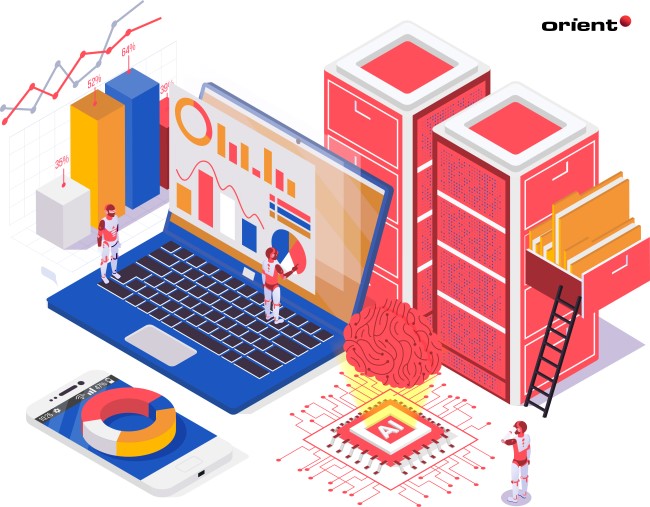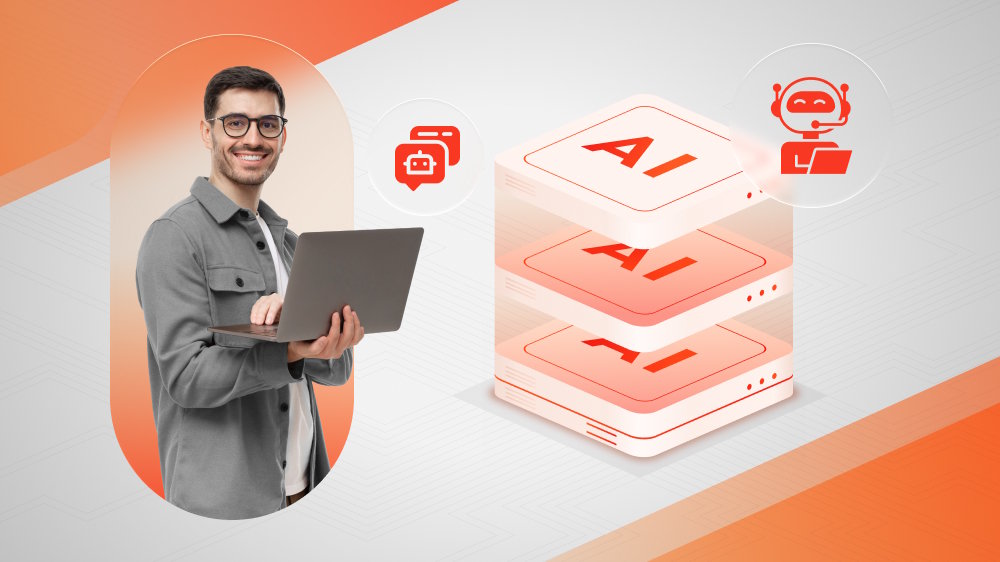
Robotic Process Automation in Banking & Finance: The Role & Real-World Applications
Let's explore the dynamic role of robotic process automation in banking and financial industries, where automation and human expertise harmonize to redefine service excellence.

Content Map
More chaptersIn a heavily regulated industry like banking, financial institutions are grappling with formidable challenges: A high volume of repetitive processes and manual tasks prone to errors, strict regulatory requirements, growing customer demands for digital experiences, and hefty operational costs.
In such a context, the integration of automation technologies is no longer optional, but it is a strategic imperative for those who look for a balance between accuracy, speed, and compliance in order to keep the banking services smooth and effective. Robotic Process Automation (RPA), Intelligent Process Automation (IPA), and Agentic Process Automation (APA) form three pivotal pillars reshaping how banks and financial institutions operate in an evolving digital landscape. Whether implemented in combination or in isolation, these technologies each contribute to driving financial process automation, enabling faster, more accurate, and more scalable banking operations while ensuring compliance and enhancing customer satisfaction.

Within the scope of this article, we will only delve into the role of RPA in modern banking operations. In detail, we will examine why it matters, explore its real-world applications, and outline best practices for implementing automation in an effective manner. Our ultimate goal is to provide a clear roadmap for institutions to harness RPA solutions not just as cost-cutting tools but as a catalyst for operational excellence and competitive advantage.
Key Takeaways:
In the face of high transaction volumes, strict regulations, rising customer expectations, and cost pressures, RPA has shifted from a technical upgrade to an essential operational infrastructure for modern banking.
- Workforce Optimization: Free bank employees from repetitive, manual tasks like data entry, account reconciliation, and report generation, allowing them to focus on higher-value, customer-facing work.
- Cost Savings: Cut operational expenses by automating labor-intensive processes, reducing overtime, minimizing errors, and avoiding the costs of seasonal or temporary staffing.
- Operational Efficiency: Speed up time-consuming workflows, reduce handoff delays, and improve turnaround times for both internal and customer-facing processes.
- On-Demand Scalability: Easily scale automation capacity during peak periods, such as quarter-end reporting or promotional campaigns, and scale back during quieter times to keep operations lean.
- Auditability and Compliance: Create detailed, tamper-proof logs of every automated action, simplifying regulatory reporting, supporting internal audits, and ensuring adherence to KYC, AML, GDPR, and other financial regulations.
- Customer Satisfaction: Deliver faster, more accurate services like account opening, loan approvals, and dispute resolution, while freeing human agents to handle complex, relationship-driven interactions.
- Integration with Legacy Systems: Work at the user interface level to connect with decades-old core banking systems, enabling process automation without costly IT overhauls or system replacements.
- Fraud Detection and Risk Management: Monitor transactions in real time, flag anomalies, and support proactive risk mitigation, especially when paired with AI or ML capabilities.
What’s the Role of Robotic Process Automation (RPA) in Banking Operations?
In brief, RPA refers to the use of software “robots” or rule-based automation solutions to streamline repetitive tasks and manual processes previously handled by humans. These bots can automate tasks by following predefined instructions. Transcending merely automating repetitive tasks, RPA bots are capable of mimicking human interactions with digital systems. They can take over structured, rule-based tasks, such as manual data entry, file manipulation, transaction monitoring, compliance reporting, and more.
In the banking sector, known for massive volumes of financial data and transactions, extensive paperwork, strict regulatory obligations, and legacy systems, RPA plays a critical role. It has become an enabler of digital transformation, which allows banks and financial service providers alike to modernize core processes without completely overhauling legacy systems, reducing risk and cost pressure while boosting agility. RPA in banking can be augmented by artificial intelligence (AI), machine learning, and natural language processing for intelligent document processing and decision support.

Here’s a breakdown of why robotic process automation matters in banking today:
Workforce Optimization
The most immediate and measurable benefit of RPA implementation in banking is the ability to optimize resource utilization while saving operational costs.
Traditionally, bank employees are tasked with highly repetitive, routine tasks, such as data entry, credit checks, account reconciliation, report generation, customer form processing, etc. These duties are not only involved with complex processes but are also time-consuming and prone to human errors, not to mention the fact that staff have to handle their tasks manually. This demands large teams and lots of time to manage day-to-day operations and maintain stability.

In automated workflows, RPA bots can streamline lengthy processes by automating all repetitive, rule-based tasks. Banks are allowed to make full use of their employees’ strategic potential and free up human resources for more meaningful, judgment-based, and customer-facing work. For example, bank staff can concentrate on relationship-building, financial advising, or improving the customer experience rather than manually validating customer data for the account opening process. Not only do RPA solutions enhance workforce agility, but RPA also enables them to increase employee satisfaction and productivity while reducing burnout and turnover.
Substantial Cost-Savings
From a financial perspective, robotic process automation delivers measurable and often dramatic cost efficiencies. According to studies and industry benchmarks, the adoption of RPA and AI has helped banks cut operational costs up to 60% for selected processes. This is because software bots take over repetitive processes and tasks, which drastically reduces the need for manual labor and human intervention in back-office and middle-office operations. Banks and financial institutions can benefit from a continuous workflow at a fraction of the cost of a full-time human workforce since bots can operate around the clock without breaks, overtime, or sick leave.

Also, intelligent automation minimizes overtime expenses, reduces error-related rework, and lessens the need for seasonal or temporary staffing during peak workloads. Last but not least, as RPA facilitates high accuracy and consistency, it helps banks avoid the hidden costs of rework, regulatory fines, or customer dissatisfaction caused by human errors.
All these savings ultimately free up capital that can be reinvested into innovation initiatives, digital infrastructure upgrades, and customer-focused services. Beyond the direct financial benefits, the reduction in operational friction also accelerates service delivery. In the financial services industry, the ability to deliver accurate results quickly is not just a plus but a decisive competitive advantage.
Greater Operational Efficiency & On-Demand Scalability
Along with cost and resource optimization, RPA empowers banks to remain flexible, responsive, and operationally lean. Automated workflows streamline operations, speed up time-consuming tasks, and reduce handoff delays - all of which boost the turnaround time for both internal and customer-facing processes.

Unlike human workers, RPA bots are easily scalable on demand. During peak periods when the volume of financial transactions and customer interactions is high, such as the end of a fiscal quarter, new product rollouts, or regulatory reporting cycles, banks are able to scale up bot usage to adapt accordingly instead of hiring and training temporary staff. Once demand subsides, bot usage can be scaled back just as easily, which keeps operations lean and resources optimized year-round.
Auditability
Aside from significant cost savings, one of the most valuable yet sometimes overlooked advantages of RPA in banking operations is auditability. Each and every action handled by a software bot is automatically logged, time-stamped, and stored in a tamper-proof digital record. This translates into a built-in audit trail.

Instead of manually collecting process evidence or continuously monitoring transactions, compliance teams can easily access the transparent and retrievable history of every automated process and instantly pull comprehensive bot activity logs to demonstrate adherence to KYC (Know Your Customer), AML (Anti-money Laundering), GDPR, or other financial regulations. This enhanced visibility into process execution is not only essential for meeting compliance requirements but also supports internal governance, risk management, and error investigation. If any suspicious activity or exception occurs, auditors can quickly trace its origin, pinpoint the exact process step, and implement corrective measures.
Improve Customer Satisfaction
Nowadays, customer expectations are shaped by speed, convenience, and accuracy through their experiences. This fact remains true in the banking sector. Delays in processing transactions, errors in account management, or slow responses to service requests are the least acceptable, and they may quickly erode trust and loyalty. At this point, RPA directly addresses these pain points by enabling banks to deliver faster, error-free, and consistent services across multiple channels.

As aforementioned, RPA is integrated into banking systems to help automate most of the routine yet critical customer-facing tasks (E.g., account opening, loan application processing, KYC verification, and dispute resolution). Customers can receive approvals, updates, and resolutions in hours rather than days. Plus, with the 24/7 availability and bots handling repetitive customer inquiries and transaction data, human agents can focus on complex, high-touch interactions that require empathy and personalized attention. Or in simpler words, they have free hands to work on client-side aspects.
Seamless Integration with Existing Systems
The last but not least important advantage of RPA is its ability to work effortlessly with decades-old legacy systems that lack modern APIs. RPA can integrate smoothly with existing banking systems and infrastructures through the user interface - logging in, navigating screens, entering or extracting data, and triggering actions without altering the underlying code. This allows automation without costly IT changes or system replacements.

This non-invasive approach enables connecting siloed systems, automating banking processes across multiple platforms, and modernizing workflows without disrupting operations. The result is faster implementation, minimal IT disruption, and significant cost savings, making RPA a true digital bridge between old and new technologies.
The Real-Life Use Cases of RPA in the Banking Sector
Far from being a futuristic experiment, RPA has already proven its worth in the banking industry. Not to replace core banking systems or human agents, robotic process automation has become one of the most transformative forces in modern banking and finance. What started as only a cost-cutting method has now evolved into a strategic enabler that helps banking and financial institutions scale services and unlock new levels of agility across banking processes and operations.

Customer Onboarding & KYC
This is one of the most impactful applications of robotic process automation in banking. Both customer onboarding and Know Your Customer (KYC) are compliance-heavy tasks that involve collecting, verifying, and validating customer information as well as processing a range of documents. When done manually, these processes can cost lots of time and require continuous human oversight.
Banks apply RPA technology in their workflows to automate document scanning, extract relevant information, and cross-verify it with internal or third-party databases. This not only significantly cuts processing time, from days to minutes, and enhances customer experience but also better manage regulatory compliance. Similarly, RPA is used to streamline loan, mortgage, and invoice processing, where bots gather applicant data, assess eligibility based on predefined rules, and update loan management systems.
Credit Card & Loan Processing
RPA streamlines the time-sensitive and paperwork-heavy functions. Manual checks, such as gathering customer data, verifying documents, and performing credit and eligibility assessments, slow down approvals and increase error risk. Instead, RPA bots can pull info from application forms, cross-check it with internal databases and external credit bureaus, apply eligibility rules, and update core banking systems all within a shorter time compared to when done manually. This automation drastically reduces the normal time to process data, but not at the cost of accuracy or adherence to the lending regulations. The outcome is faster service, fewer errors, and a smoother customer experience that strengthens competitive advantage.
For credit card applications, RPA enables instant decision-making by integrating identity checks, fraud screening, and approval workflows into a single, seamless process. In loan processing, it helps manage large volumes of applications efficiently, especially during peak periods, such as promotional campaigns or economic stimulus periods. The result is faster service delivery, fewer bottlenecks, and an enhanced customer experience, giving banks a strong competitive edge.
Fraud Detection & Anti-Money Laundering (AML)
As you can see, fraud prevention and AML compliance are two of the top priorities in today’s digital banking environment. Monitoring transactions for suspicious activity is a resource-heavy task when done completely manually. When you implement RPA in monitoring, what takes hours can now be done in minutes. Bots can continuously scan data against predefined risk rules, regulatory checklists, and watchlists, instantly flagging anomalies for further investigation.
If combined with AI or ML models, RPA solutions become more powerful, capable of identifying unusual patterns and triggering alerts for further investigation. This real-time monitoring capability ensures banks remain compliant with AML regulations while protecting both the institution and its customers from financial crime. This combination not only strengthens AML (Anti-Money Laundering) and KYC (Know Your Customer) compliance but also reduces the time between detection and action, allowing banks to respond to threats faster and with greater accuracy.
Account Reconciliation
Daily, monthly, and quarterly account reconciliations are critical for ensuring accurate financial records, but the manual process can be tedious and error-prone. RPA bots can automatically extract transaction data from multiple sources, match records, highlight discrepancies, and even initiate corrective actions. This not only speeds up the reconciliation process but also improves accuracy, freeing finance teams to focus on higher-value analysis instead of routine matching tasks.
Regulatory Reporting
Banks and financial service providers operate under strict regulations that require timely, precise, and detailed reports to be submitted to authorities. Preparing these reports often involves gathering data from multiple systems, formatting it correctly, and ensuring compliance with complex rules. Using RPA automates this entire process, from pulling data, validating it against regulatory requirements, to compiling reports and submitting them electronically. By doing so, banks and their staff can mitigate compliance risks, eliminate last-minute rushes, and maintain a perfect audit trail for every submission.
Customer Service Automation
Usually, support teams must handle a high volume of repetitive requests such as balance inquiries, statement requests, password resets, and transaction history lookups. RPA bots, often integrated with AI-powered chatbots, can handle these routine queries instantly and offer customers 24/7 self-service options. This automation frees human agents to get their hands on complex, relationship-driven interactions while still ensuring fast, consistent responses for common requests.
Final Thoughts
The institutional adoption of RPA in banking is no longer a technical upgrade in banking systems and operations. It is now an essential layer of operational infrastructure, especially in an industry where efficiency, accuracy, and compliance straightforwardly influence competitiveness. The RPA implementation in banking services and operations empowers the service providers to modernize their workflows to streamline operations, reduce costs, and deliver faster, more reliable services to customers, all without overhauling legacy systems. However, in order to achieve these outcomes, you need more than just deploying automation tools; you need the right expertise, a tailored implementation strategy, and a long-term vision for intelligent automation.
A reliable partner is exactly what you should be looking for. This is where Orient Software comes in. Who are we? Orient Software is a leading software development outsourcing company based in Vietnam. With deep experience in delivering custom automation solutions and a proven track record of successful projects, our team helps financial institutions design, develop, and implement RPA frameworks that align perfectly with business objectives. From identifying high-impact use cases to ensuring seamless integration with existing systems, we provide end-to-end support that transforms RPA from a promising concept into measurable results.
Not only in the rapidly evolving banking landscape, but Orient Software also empowers businesses across industries and sectors to embrace RPA as essential infrastructure to unlock its full potential to drive innovation, enhance customer experience, and maintain a competitive edge for years to come. Contact us today for further discussion.






